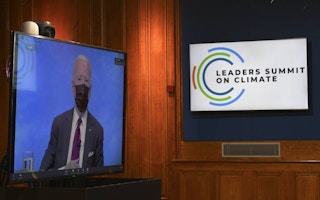When US Vice President Kamala Harris introduced the eagerly-awaited virtual climate summit on Thursday, something didn’t sound right.
As she welcomed the leaders of 40 countries to the event, including China’s Xi Jinping and India’s Narendra Modi, Harris’ speech had a jarring echo. It was hard to listen to.
That was just the first of several mishaps throwing up awkward delays and embarrassing gaffes, highlighting the perils of online climate diplomacy in a world still battling Covid-19.
The most cringeworthy moment came when French President Emmanuel Macron was cut off mid-speech as the screen switched to a confused Russian President Vladimir Putin.
A long silence ensued before Putin gave his speech, after which Macron’s taped remarks were restarted.
Apologising for “technical difficulties,” US Secretary of State Antony Blinken managed to get the meeting back on track.
As entertaining as these blunders may be, they illustrate the challenges of collaborating online - and raise questions about whether global climate action could suffer.
While the new coronavirus pandemic prohibits world leaders meeting en masse, this year is shaping up to be pivotal for climate action, as nations aim to limit global warming to 1.5 degrees Celsius above pre-industrial levels.
Plans are still up in the air for a United Nations biodiversity summit in Kunming, China - which has been repeatedly delayed - and the crucial COP26 meeting in Glasgow.
“
The bigger issue is the inequitable access to these technology platforms by different countries, by different groups.
Alden Meyer, senior associate, E3G
Stuck on mute
After a rocky start to US President Joe Biden’s climate summit, leaders took turns to give speeches, with many announcing updated targets to meet global climate goals.
Chinese President Xi Jinping spoke for several seconds before a translator could be heard, while random phone dialing noises interrupted other contributions.
And later, Australian Prime Minister Scott Morrison fell foul of a mishap that has struck many Zoom calls - he was stuck on mute for the first chunk of his vital speech.
“There are going to be technology glitches in any kind of virtual interaction,” Alden Meyer, a veteran of United Nations summits and senior associate at climate change think-tank E3G.
But no IT guru can replicate some of the vital parts of face-to-face negotiations that push climate action forward.
“An essential element of climate diplomacy is those last-minute political decisions that are made often in the (small) hours of the morning,” Meyer said, adding that personal interactions and body language can be key to finding compromises.
Meyer said progress can be made online, particularly with innovations like virtual breakout rooms, but warned of the digital divide within and between nations.
“The bigger issue is the inequitable access to these technology platforms by different countries, by different groups,” he said.
This story was published with permission from Thomson Reuters Foundation, the charitable arm of Thomson Reuters, that covers humanitarian news, climate change, resilience, women’s rights, trafficking and property rights. Visit http://news.trust.org/climate.










